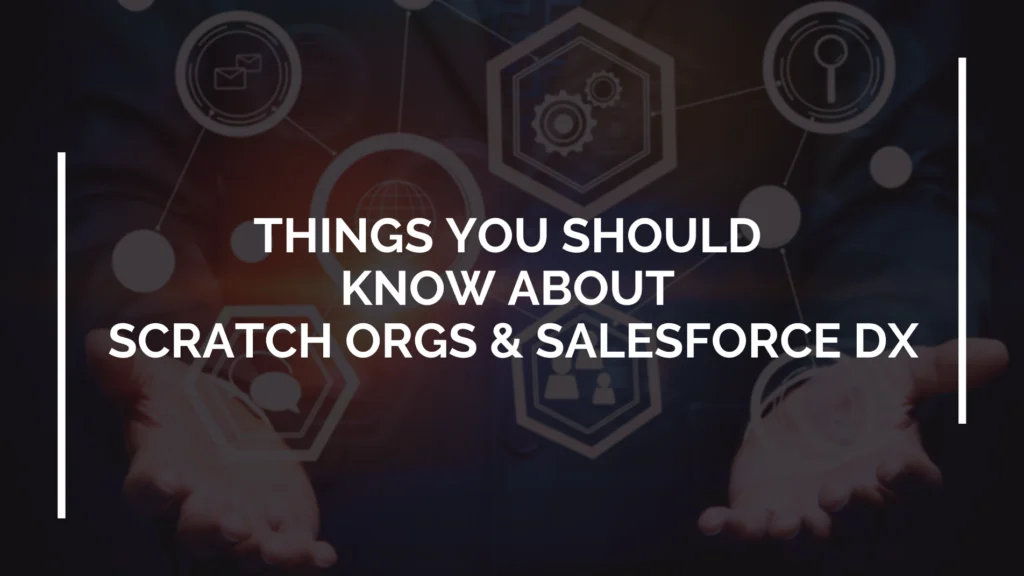
Breaking Top 5 Myths about Scratch Orgs & Salesforce DX
Does your business require a modern developer experience that changes the way your Salesforce developers create applications? Then Salesforce DX is the right answer, as it offers an integrated, end-to-end lifecycle for achieving higher performance with Agile methodologies.
Salesforce DX (Developer Experience ) is a set of tools and in a nutshell offers numerous benefits for your Salesforce development team such as source-driven development and disposable deployment, open-standard, out of the box experiences, rapid Salesforce development and testing with novel types of scratch orgs, facilitates continuous testing and automation, and efficiently delivers apps with CLI-centric approach.
Salesforce DX uses Scratch org, a novel type of org with limited overheads used for testing your application and accelerating the development process. The Developer Hub is the main org that creates and manages your scratch org. It enables your developers to quickly and continuously build your apps by using source and metadata. It also enables employee training and is ideal for testing new Salesforce features.
One core benefit of using scratch org is to take advantage of Salesforce DX, Salesforce’s modern development practice,
Why use Scratch Org in place of Sandbox?
Scratch orgs addresses the pain points for the developers. The reasons for using scratch org are:
- Scratch orgs are driven by source and simplify Devops. Scratch orgs can be used all throughout the day unlike the sandboxes. However, scratch orgs and the sandboxes are complementary to each other.
- Scratch orgs do not rely on any particular org but on the contrary they act as the single source of truth is the source repository such as Github for everything on which the developers need to work. This allows the developers to manage multiple Git branches, and use each one of them with different scratch orgs and merge them back into the main.
- Save the developer’s time by capturing the complete picture of the org, the developer is developing against.
- Scratch orgs can detect issues at an early stage to avoid bigger issues to crop in at a later stage. They offer higher levels of granularity and control out by pointing out where and when the testing was done.
- Bring consistency on how the development was done somewhere else.
- Scratch org allows the developers to enable features, non-existing in the production environment. So, there is no need to buy extra licenses or even contact Salesforce support.
- The features, configurations and preferences to be enabled by scratch orgs are held in the org definition templates. The developers can access
- The configuration values in the scratch org definition file determine the org shape. The developer can add lines on the configuration files to build Einstein bot or use person accounts.
In this post, we will provide insights on 5 myths on scratch orgs or Salesforce DX.
What are the 5 Myths about Scratch Orgs and Salesforce DX?
The 5 myths are as follows:
Scratch Orgs are Only for ISV Partners
Salesforce provides a limited number of scratch org for your business org. This is to ensure optimal performance. Scratch orgs are beneficial for quick implementation. Scratch orgs are automatically deleted after 7 days. They increase developer productivity. However, while creating sandboxes, you may not have much control over the metadata to be carried over the starting point.
Create Scratch Org with Access to Dev Hub
Salesforce offers a free limited access license, to create and manage scratch orgs. The developers can now access the Dev Hub. This also helps the developers to collaborate with others through Chatter. However, your Salesforce Admin is responsible to give permissions on the Deb Hub objects, but not all objects such as Accounts, Opportunities and Contacts.
Use Sandbox and Scratch Org in Conjunction
Sandbox and Scratch orgs are complementary to each other. Scratch orgs are disposable in nature. Scratch orgs are great for temporary deployments. They can be used for better automation and test coverage. Scratch org takes care of everything for the developers with no need to remember anything. The developer just finally pulls the changes for checking to the version control.
Not Easy to get Metadata from Sandbox to the Scratch org
It is quite often not possible to refresh your Sandbox. It is also not easy to move the metadata from the sandbox to the scratch org. However, your work as a developer becomes easier when the source of truth is SCM. In such a situation, the developer can easily obtain the metameta from the sandbox to the scratch org, merely using a command.
Save Developer’s time
Scratch org provides closer integration with VsCode. This saves time when compared with metadata deployments. Here the developer gets and pushes the data rather than pulling and pushing.
Conclusion
Scratch orgs are source-driven and disposable. Scratch orgs mimic the Salesforce orgs for automated testing. Scratch orgs are extremely beneficial for the growing development team, as it is used for training the developers.
Moreover, the scratch orgs help to reduce the pain points of the developers. Scratch orgs can be used round-the-clock and improves developer productivity. The developer need not remember anything, while using the scratch org. They can save precious time for the developer. We are ready to deliver a solution on how we use scratch orgs. Please contact us in the following link.


